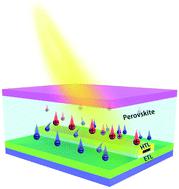当前位置:
X-MOL 学术
›
Energy Environ. Sci.
›
论文详情
Our official English website, www.x-mol.net, welcomes your
feedback! (Note: you will need to create a separate account there.)
Device physics of back-contact perovskite solar cells
Energy & Environmental Science ( IF 32.4 ) Pub Date : 2020-04-14 , DOI: 10.1039/c9ee04203b Zhenhai Yang 1, 2, 3, 4, 5 , Weichuang Yang 1, 2, 3, 4 , Xi Yang 1, 2, 3, 4 , J. C. Greer 4, 5, 6, 7, 8 , Jiang Sheng 1, 2, 3, 4 , Baojie Yan 1, 2, 3, 4 , Jichun Ye 1, 2, 3, 4
Energy & Environmental Science ( IF 32.4 ) Pub Date : 2020-04-14 , DOI: 10.1039/c9ee04203b Zhenhai Yang 1, 2, 3, 4, 5 , Weichuang Yang 1, 2, 3, 4 , Xi Yang 1, 2, 3, 4 , J. C. Greer 4, 5, 6, 7, 8 , Jiang Sheng 1, 2, 3, 4 , Baojie Yan 1, 2, 3, 4 , Jichun Ye 1, 2, 3, 4
Affiliation

|
Back-contact perovskite solar cells (PSCs) are a promising candidate to further increase power conversion efficiency (PCE) and have been the subject of many investigations. However their full potential has not been achieved due to a lack of a complete understanding of their operation from a device physics perspective. In this study, a detailed photoelectrical model for back-contact PSCs is developed by coupling a drift-diffusion description of a free charge transport model with ion migration currents and emitted-carrier generation resulting from photon recycling. By studying the influence of relevant electrical parameters, the interplay between charge generation, transport and recombination is revealed to further clarify the design principles based on devices with a back-contact structure. Although devices featuring the back-contact structure exhibit sensitivity to electrical parameters, a high PCE exceeding 25% is predicted if the interface passivation and perovskite film quality can be well controlled. Different conduction band and valence band offsets offering various screening opportunities for functional materials with high efficiencies are introduced. Additionally, the simulated results revealed that mobile ions degrade the device performance if the average ion concentration exceeds 1016 cm−3. Furthermore, we point out that photon recycling can effectively compensate for radiative recombination, thereby resulting in an improved open circuit voltage. The results provide a new understanding of the carrier transport dynamics, ion migration, and photon recycling effects for the back-contact structure, which can be applied for a systematic improvement in the design of high efficiency PSCs.
中文翻译:

背接触钙钛矿太阳能电池的器件物理
背接触钙钛矿太阳能电池(PSC)是进一步提高功率转换效率(PCE)的有前途的候选者,并且已经成为许多研究的主题。然而,由于缺乏从设备物理学的角度对其操作的全面了解,因此尚未发挥出它们的全部潜力。在这项研究中,通过将自由电荷传输模型的漂移扩散描述与离子迁移电流和光子回收产生的发射载流子耦合,开发了用于背接触式PSC的详细光电模型。通过研究相关电参数的影响,揭示了电荷产生,传输和复合之间的相互作用,以进一步阐明基于具有背接触结构的器件的设计原理。尽管具有背面接触结构的器件对电参数表现出敏感性,但如果可以很好地控制界面钝化和钙钛矿薄膜的质量,则预计PCE会超过25%。介绍了不同的导带和价带偏移量,为高效功能材料提供了多种筛选机会。此外,模拟结果还表明,如果平均离子浓度超过10,移动离子会降低设备性能。16厘米-3。此外,我们指出,光子回收可以有效地补偿辐射复合,从而改善开路电压。结果为背接触结构的载流子传输动力学,离子迁移和光子循环效应提供了新的认识,可用于系统改进高效PSC的设计。
更新日期:2020-06-19
中文翻译:

背接触钙钛矿太阳能电池的器件物理
背接触钙钛矿太阳能电池(PSC)是进一步提高功率转换效率(PCE)的有前途的候选者,并且已经成为许多研究的主题。然而,由于缺乏从设备物理学的角度对其操作的全面了解,因此尚未发挥出它们的全部潜力。在这项研究中,通过将自由电荷传输模型的漂移扩散描述与离子迁移电流和光子回收产生的发射载流子耦合,开发了用于背接触式PSC的详细光电模型。通过研究相关电参数的影响,揭示了电荷产生,传输和复合之间的相互作用,以进一步阐明基于具有背接触结构的器件的设计原理。尽管具有背面接触结构的器件对电参数表现出敏感性,但如果可以很好地控制界面钝化和钙钛矿薄膜的质量,则预计PCE会超过25%。介绍了不同的导带和价带偏移量,为高效功能材料提供了多种筛选机会。此外,模拟结果还表明,如果平均离子浓度超过10,移动离子会降低设备性能。16厘米-3。此外,我们指出,光子回收可以有效地补偿辐射复合,从而改善开路电压。结果为背接触结构的载流子传输动力学,离子迁移和光子循环效应提供了新的认识,可用于系统改进高效PSC的设计。











































 京公网安备 11010802027423号
京公网安备 11010802027423号